
|
History of Sex in Cinema: 1967 |
| Movie Title/Year and Film/Scene Description | ||||||||||||||||||||||||||

|
Belle de Jour (1967, Fr.) (aka Beauty of the Day) Luis Bunuel's groundmaking film about repressed sexuality, his first color film, told about bored, repressed, blonde upper-class Parisian newlywed housewife Sévérine Serizy (Catherine Deneuve). The carnal film ended ambiguously and tragically when her escapades as a part-time prostitute in a chic brothel brought sexual fulfillment (she told her husband, "Every day I love you more") - but also imagined physical (and emotional) harm to her husband. She was unhappily married to respectful society surgeon Dr. Pierre Serizy (Jean Sorel), in an unconsummated and frigid relationship. In the opening sequence, she experienced one of her most imaginative and recurring daydreams (of gang-rape, masochism - whippings and bondage, and eroticism). With the off-screen dreamy sounds of her turn-ons (meowing of cats and the jingling of carriage bells), she was driven in an open carriage (landau) through the woods of an estate where her husband ordered her dragged from the coach, and instructed the coachmen to gag her and tie her hands/arms to a nearby tree above her. There, he pulled down her mouth gag and threatened: "If you scream, I'll kill you." The back of her dress (and bra) were torn off and her bare back was whipped (pleasurably) by two coachmen, as she screamed out: "I beg of you, don't let the cats loose!"
Afterwards, Pierre also told one of the whipping coachman (Michel Charrel) before a presumed scene of rape: "That's enough. She's all yours ...Go ahead" --- the scene abruptly cut back to Severine's bedroom where she was lying in bed and her PJ'd husband Pierre (of one year) was in the bathroom, reflected in a mirror, who asked: "Severine, what are you thinking about? Tell me"; she answered: "About you, about us" - and mentioned that she had the coach fantasy again - theirs was an unconsummated, chaste and frigid relationship - the reason she engaged in elaborate S&M fantasies; they kissed before retiring in separate single beds, and did not consummate their love. There were a few brief flashbacks to Severine's early life as a young girl (to partly explain her mental state), when she was groped by a blue-collar worker, and she rejected a Communion wafer during a Catholic (guilt-inducing) service. Vivid sexual imaginings led her to hire herself out to brothel Madame Anais (Genevieve Page), who told her: "My girls have to be polite and very cheerful. You have to enjoy your work." Enjoying part-time suburban prostitution during afternoons only, she took the "very simple and very cute" name - 'Belle de Jour' - "easy to remember." She soon experienced a variety of strange clients - some of whom enjoyed role-playing. In one fantasy S&M sequence, Severine wearing an immaculate white gown, was tied up in a barnyard setting while Pierre and older family friend Henri Husson (Michel Piccoli) pelted her with thick black mud (or cow dung?) and called her horrific names: "Little Slut," "Bitch," "Old Whore," "Maggot," "Pig," "Scum," "Garbage," "Tramp," and "Slut." Just before the mud-slinging, Husson had pointed out his two prized bulls: Remorse and Expiation. In another scene, after she had serviced a strange East Asian client (Iska Khan) with a mysterious box, Severine's fearful but sympathetic brothel maid Pallas (Marguerite Muni) said that she had been frightened: ("That man would frighten me, too. It must be painful sometimes"); as she partially sat up on the bed, Severine replied: "How would you know, Pallas?"
In the film's most graphic set-piece, while seated alone at an outdoor cafe table, a 19th century costumed duke-nobleman (Georges Marchal) approached Severine from a horse-drawn carriage, and brought her to his manor-chateau in the woods. As part of his sexual fetish, she was required to impersonate his dead daughter ("Worms are eating you up. And the smell of dead flowers fills the room"), by lying in a coffin wearing a transparent black nightgown over her nude body, while he placed lilies on her chest and masturbated nearby. They were interrupted by the butler who asked: "Shall I bring in the cats?" The perturbed duke shouted back: "To Hell with you and your cats!" Afterwards, she was dismissed into the rain outdoors. In another carriage-woods masochistic fantasy, Severine was bound to a tree and shot in the left temple (after an imagined duel between Husson and Pierre). Pierre approached and kissed her. The concluding ambiguous sequence (another hallucinated fantasy or wish-fulfillment in Severine's unstable mind) found Pierre comatose in a wheelchair after being shot three times by one of her jealous johns. But suddenly he sat up, and asked: "What are you thinking about?" (she answered: "About you"). He arose from his wheelchair, walked to the other side of the room, and poured himself a drink - the ubiquitous off-screen sounds of meowing cats and jingling bells were heard. When he suggested going to the mountains with her, she asked if he heard the bells and went to the window, where she watched from the balcony as the carriage (with two coachmen) approached - as the film ended. |
   Severine with Pierre   As a Young Girl  Severine with Madame Anais (Genevieve Page)      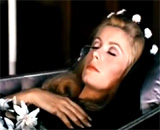  Sévérine Serizy (Catherine Deneuve) |
||||||||||||||||||||||||
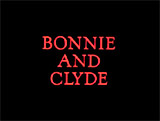
|
Bonnie and Clyde (1967) Arthur Penn's definitive film of the sixties Bonnie and Clyde (1967) was one of the most talked-about, volatile, and controversial crime/gangster films of all-time, combining comedy, terror, love, and ferocious violence. It romanticized violence in its tale of an infamous criminal couple who proclaimed: "They're young...they're in love...and they kill people." Both tragic outlaw figures exemplified 'innocents on the run' who clung to each other and tried to function as a family. The film opened with a colorful closeup of red, luscious lips (that were being licked after lipstick had been applied). The immense lips belonged to blonde Bonnie Parker (Faye Dunaway) - a bored, beautiful, and sexually-frustrated, Depression-era Texas cafe waitress who was naked and narcissistically primping in front of a mirror. Her teasing and nude appearance at her bedroom window occurred as Clyde Barrow (Warren Beatty) eyed her Mama's car out front. She quickly dressed and descended the stairs to join him. One of the film's lobby posters described their first auspicious meeting: "They met in 1930. She was stark naked, yelling at him out the window while he tried to steal her mother's car. In a matter of minutes they robbed a store, fired a few shots, and then stole somebody else's car. At that point, they had not yet been introduced."
This film illustrated the sexy interplay between the two. Soon after, Clyde showed off his gun and bounced a wooden matchstick between his teeth (shot at an upward angle as a trembling phallic symbol), although he was later revealed to be impotent. The film's overall impact was heightened by its open examination of the gallant Clyde's sexuality-impotence and the link to his gun-toting violence. To fulfill heartthrob Warren Beatty's image as a sex-symbol, he was finally able to consummate his love for Bonnie by film's end, although it was dubiously historical. Afterwards, Bonnie assured Clyde: "You did just perfect," after which he complimented himself while chuckling: "I did, didn't I? I mean, I really did. I never figured on that. Damn." In the next bedroom scene, they discussed their relationship, although they were soon doomed to die:
|
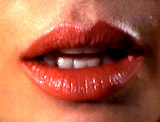  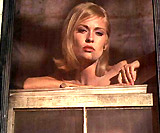 Bonnie Parker's Sexy Introduction   Bonnie (Faye Dunaway) and Clyde (Warren Beatty) |
||||||||||||||||||||||||

|
Cool Hand Luke (1967) Director Stuart Rosenberg's moving character study Cool Hand Luke (1967) told of a non-conformist, anti-hero loner, "Cool Hand" Luke (Paul Newman) who bullheadedly resisted authority and the Establishment. The film's theme was about the outsider-protagonist who transformed the occupants of a Southern chain gang institution and tragically sacrificed himself at the end. This chain-gang prison film contained the titillating scene of the prisoners digging a ditch by the roadside in the scorching hot sun -- when a blonde-haired, shapely, well-endowed and sexy young woman (Joy Harmon) in a nearby house prepared to wash her car. Her provocative activity sent the men into a voyeuristic, frustrated frenzy. She brought out a radio and turned it on, signaling the beginning of her sexual act. As she opened up the nozzle on her watering hose, a particularly-apt phallic symbol, the men perked up and attentively spied "the scenery." One of the prisoners couldn't endure the lustful suffering she was creating: "Oh man, oh man, I'm dyin'."
She proceeded to wet down the car and then lathered and caressed white, frothy soap suds over the car's surfaces. She tempted and stimulated the men even further in the symbolic simulation of the sex act. She looked into the car's rear view mirror and into one of the tire's shiny hubcaps to look back to see how the men were being pleasured. Her loose-fitting blouse with well-endowed breasts began to open up and taunt them. Gambler (Wayne Rogers) observed:
The men dug more vigorously as she heightened her own cleansing activity. Dragline (George Kennedy) prayed to the heavens to sustain his eyesight just a little longer for the girl he named Lucille: "Hey Lord, whatever I done, don't strike me blind for another couple of minutes. My Lucille!... That's Lucille, you mother-head. Anything so innocent and built like that just gotta be named Lucille." Knowing that she had a ripe and attentive audience, the blonde rubbed the car harder and harder. In the most blatantly sexual act of all - the orgasmic conclusion to her show - she squeezed the white foam out of her sponge and rubbed the soap suds across her abdomen. Luke knew what she was doing: "She knows exactly what she's doin'. She's drivin' us crazy and lovin' every minute of it." She gently drank from the end of the penis-shaped hose and then while washing the roof of the car, her soaped-up, ample breasts were squeezed as they rubbed back and forth across the car's window. |
  The Girl (Joy Harmon) |
||||||||||||||||||||||||

|
The Fearless Vampire Killers (1967) (aka Dance of the Vampires or Pardon Me... But Your Teeth Are in My Neck) In director Roman Polanski's vampire horror spoof, two vampire hunters (Professor Abronsius (Jack MacGowran) and his assistant Alfred (Roman Polanski)) attempted to destroy an undead nobleman, while rescuing a beautiful maiden. The young, innocent and buxom innkeeper's daughter Sarah Shagal (Sharon Tate, director Polanski's soon-to-be-wife in her debut feature film appearance) bathed twice in a tub in the most sensual scenes of the film. Semi-nude shots heavily publicized were not in the film, but in promotional materials including a March 1967 Playboy pictorial shot by Polanski. In the first sequence set in the local village's tavern, vampire Count Von Krolock (Ferdy Mayne) descended through the ceiling, and flared his fangs at her before biting her. She flailed around in the tub as her neck was bitten, and her mouth was covered (to prevent screaming). In the second sequence, the kidnapped Sarah was oblivious to danger when Alfred attempted to save and warn her by following after him ("l'm going to save you. We'll go away together"), but all she wanted to do was attend the midnight ball and wear her beautiful red dress.
|
|||||||||||||||||||||||||

|
The Fox (1967, Can.) Director Mark Rydell's first feature film was a stark adaptation of D. H. Lawrence's 1923 novella of lesbian love. The candid and controversial drama was originally rated R in 1968 (for its scene of nude masturbation and mild scenes of sexuality, lesbian and heterosexual), but then was re-edited and rated PG in 1973. It examined the lives of two female lovers on an isolated, snowbound farmhouse (a self-sustaining chicken farm) in Canada, who shared the same bed in a sublimated lesbian relationship:
The arrival of a third person - self-confident merchant seaman Paul Renfield (Keir Dullea) - symbolically and metaphorically, the predatory 'male' fox (who challenged the coop and killed the real-live fox), disrupted and changed the relationship between the two women within the tense love triangle. There were tasteful and discrete scenes of sexuality:
In one telling scene after his arrival, Paul asked Jill why she had never married:
By film's end, the bisexual character of Ellen, who originally decided not to abandon Jill for Paul, chose to start a new life with Paul after Jill was killed by a falling tree. Jill had stubbornly refused to heed Paul's warning and move out of the tree's possible path when it was about to be chopped down by Paul.
|
  Ellen (Anne Heywood) with Jill (Sandy Dennis)  Paul with Ellen   The Death of Jill |
||||||||||||||||||||||||
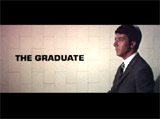
|
The Graduate (1967) Mike Nichol's award-winning, milestone film of the 1960s The Graduate (1967) was a bold social satire film combining adultery, nudity, and anti-establishment subject matter. It featured an average-looking newcomer named Dustin Hoffman in the lead role as young graduate Ben Braddock who would experience an illicit and sexy seduction (and awakening) by older, provocative and predatory married female - Mrs. Robinson (Anne Bancroft) - the frustrated wife of his father's law partner. She quizzically asked him: "You want me to seduce you, is that what you're trying to tell me, Benjamin?" (with his befuddled reply-question: "Mrs. Robinson, you're trying to seduce me? Aren't you?"). She assaulted him in her own home by exposing her breasts to him (seen in split-second, jump-cut flashes but first reflected in the picture of her daughter Elaine (Katharine Ross)) in her bedroom, and by blocking his exit.
At the same time that he entered into an affair with her, Benjamin dated the more appropriately-aged Elaine. On their first date, he deliberately tried to put Elaine off by being offensive. Without communicating with her (wearing his sunglasses at night), he drove recklessly in his sports car and then marched ahead of her into a tawdry strip joint to humiliate her. The stripper (Lainie Miller) twirled the dangling tassels on her bare, rotating breasts directly behind Elaine's head, while Ben asked:
He removed his sunglasses [his barrier] as he saw tears forming in her eyes, and stopped the tawdry show. Disgusted and humiliated in shame, Elaine ran out. In the climactic concluding scene, Benjamin interrupted her marriage at a church and took her away on a city bus to an uncertain future. |
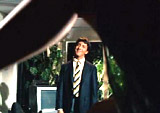    Benjamin (Dustin Hoffman) with Mrs. Robinson (Anne Bancroft)   
|
||||||||||||||||||||||||

|
Guess Who's Coming to Dinner (1967) Stanley Kramer's and Columbia Pictures' socially-conscious message film explored the touchy issue of inter-racial romance. This progressive film (though dated now) was the first truly mainstream Hollywood film to portray an interracial couple's romance that turned out optimistically. The mixed couple were:
Except for one brief revolutionary view of the couple kissing (seen in a cab driver's rear view mirror on their way to the city of San Francisco from the airport), other scenes of their physical intimacy were edited out. |
 Rear-View Mirror Interracial Kiss |
||||||||||||||||||||||||

|
A Guide for the Married Man (1967) Based upon Frank Tarloff's book of the same name, this dated, misogynistic, humorless sex comedy (directed by Gene Kelly!) was of the opinion that sex and infidelity could freely be discussed, without being very visually explicit. In the film's trailer, the narrator promised to give viewers some "pointers" - with the shot of the bouncing chests of four nubile women strutting down a sidewalk, a busty look at the decolletege of a waitress bending down and serving tea, and the "low-down" (a view of the swinging backside of a shapely female). This foul, light-hearted sex film was typical of a number of films of the 'sexual revolution' of the late 60s, with little in the way of nudity due to Production Code restrictions still residually in force, but with lots of leering views of stacked and teasing bombshells clothed with hip-swinging, tight outfits. The picture's gimmick was that it featured many notable cameos from Art Carney (with Lucille Ball), Jack Benny, Louis Nye, Phil Silvers, Joey Bishop, Sid Caesar (with Karen Arthur), Wally Cox (with Maureen Gaffney), Terry-Thomas (with Jayne Mansfield), Carl Reiner (with Linda Harrison as Miss Stardust), and Polly Bergen. It preached the philosophy that cheating and adultery could be taught to any husband. Bored business investment counselor Paul Manning (Walter Matthau) had been married for twelve years to Ruth (sexy and gorgeous Inger Stevens), who was undeniably gorgeous and sexy. In their bedroom, she performed breast-enhancement exercises, stripped off her leotard, and attempted to entice her disinterested husband into noticing her with a see-through nightgown. Paul was taught how to cheat by self-proclaimed, expert philanderer - his friend and neighbor Ed Stander (Robert Morse) who was married to Harriet (Claire Kelly) and cheating on her. Paul was instructed in a series of vignettes about the "do's and don'ts" of successful and failed affairs. Part of the reason for Paul's roving eye was due to his shapely and provocative married neighbor Irma Johnson (Sue Ann Langdon).
In one of the lessons (scenarios) on how not to get caught, Charlie (Joey Bishop) was found by his enraged wife (Ann Morgan Guilbert) in bed with a naked woman. When confronted ("What are you doing?") with lots of questions, he calmly denied all of the charges she asked of him, while they both dressed:
He wasn't even ashamed of himself, and when she had accepted his story, she asked: "What would you like for dinner?" The final resolution of the film came with Paul ready to cheat with striking rich brunette divorcee Jocelyn Montgomery (Elaine Devry) wearing only a sexy black bustier, and with him in a room of the Happy Hour Motel. He had second thoughts when he heard a commotion and photographers across the way, and was fearful of getting caught. He fled the room with her and quickly returned to his beloved wife. Then he found out that the authorities had arrested Ed with Mrs. Irma Johnson - who ended up with a divorce. |
  Ruth (Inger Stevens)  Miss Stardust (Linda Harrison)  Harriet Stander (Claire Kelly) |
||||||||||||||||||||||||
 
|
Sweden's landmark, avante-garde, mock-documentary film (shot with mostly hand-held cameras) allegedly included 'offensive' sexual scenes that challenged existing boundaries. US Customs seized the film in 1968, and the courts (and the Supreme Court) originally determined that the movie was 'obscene.' It was subsequently banned for its pornographic content, although this verdict was eventually overturned after appeal. Many Supreme Court battles ensued before it could be distributed. It became a benchmark film for free-speech advocates. After it was cleared and released in the US in 1969, it became a blockbuster hit, although it was often picketed. It garnered $5 million in six months (a much higher figure when adjusted for inflation). The Swedish import soon became the highest-grossing foreign film (at $20 million) released in the US for decades (a record that stood until Il Postino broke the mark in the mid 1990's), although most who watched it considered it boring and pretentious.
But by today's standards, I Am Curious (Yellow) has to be considered tame, but at that time, it helped to open the floodgates toward more explicit films, such as the X-rated Best Picture Midnight Cowboy (1969) and Bernardo Bertolucci's Last Tango in Paris (1972), and more hard-core pornography (with oral sex, penetration, and ejaculaton) exhibited in the porno chic Deep Throat (1972). The radical, experimental film-within-a-film of sexual politics told the dull and pretentious story of liberated, plumpish 22 year-old Lena (Lena Nyman), an aspiring sociologist who was investigating Swedish social and political conventions. She was curious about political issues in late 60s Sweden, with endless soul-searching, lengthy street interviews with common people about the class system, newsreel footage, scenes of protest regarding the Vietnam War, scribbled on-screen slogans, her cataloguing of information, etc.
Sexual interludes also pushed the boundaries of love-making between Lena and car salesman Borje Ahlstedt (Borje Ahlstedt) (mirrored in the film and real life by a tumultuous triangle with director Vilgot Sjoman). The scenes were shot frankly and realistically. There were scenes of full frontal nudity of both sexes (at 38 minutes into the film), simulated rear-entry intercourse, and the kissing of the male's flaccid penis (over a full hour into the film) and stroking of pubic hair. |
 Lena (Lena Nyman)  Borje (Borje Ahlstedt)    Additional Sexual Scenes |
||||||||||||||||||||||||

|
Valley of the Dolls (1967) This successful Fox film from director Mark Robson was based upon Jacqueline Susann's top-selling novel of 1966. It became Fox Studios' top money-maker hit for 1968, although it was severely criticized by most film critics. It was a trashy, kitschy, and 'it's-so-bad-it's-good' soap-opera about three aspiring starlets who had been 'corrupted' by Hollywood:
The campy classic included scenes of their sexual dalliances (never very explicit) and their failings due to pill-popping (pills=dolls) and drinking. Most of the sex (filmed in silhouette), scandal, and drug abuse seem tame by today's standards. In particular, Patty Duke was miscast with an over-acting portrayal of bitchy Neely O'Hara as she pranced around in her bra and panties after catching designer Ted Casablanca (Alex Davion) cheating on her by skinny-dipping with a young female in their pool. She screamed out:
She was soon fired from her job, and now down and out (and completely strung out), she stumbled outside of a number of topless bars and adult theaters in the Bowery (where Jennifer's 'cutie nudie' picture "The Flame of Montmartre" was showing at the Lyric), where she exclaimed:
She was forced to dry out at a sanitarium. The film was also noted for various sequences including:
|
 Jennifer North (Sharon Tate)  Neely (Patty Duke)   Jennifer (Sharon Tate) 
Helen (Susan Hayward) |
||||||||||||||||||||||||

|
Weekend (1967, Fr) Writer/director Jean Luc-Godard's prescient, nihilistic and politicized black comedy was a critique of the bored and selfish bourgeoisie. It was an allegory about the breakdown of society. Its title derived from the time-frame of the film involving an upper-class, bickering murderous Parisian couple on a weekend trip. The film was controversial for displaying many taboos, including patricide, rape, immolation, animal cruelty, and cannibalism. The two main detestable, bickering characters on an outdoor Parisian apartment balcony were:
Both had contempt for each other - the two venal marrieds both had other lovers and were secretly plotting to murder each other. And both were about to take a weekend car trip to her parents' place in Oinville to visit her dying father and ensure the acquisition of inheritance money from him (they had been slowly poisoning his food for five years). It started with the unusual, lengthy sequence of a sexually-graphic "orgy" or "menage a trois" monologue (with loud organ music accompaniment often drowning out the most provocative and offensive words). Corinne was obscured by being silhouetted and dressed in her panties and bra and sitting on the edge of a desk, offhandedly and monotonously describing to her fully-dressed husband a recent bizarre orgiastic sexual encounter. [It borrowed from a similar scene in Ingmar Bergman's Persona (1966, Swe.).] He was play-acting a counselor/analyst as she presented her story with a disinterested tone. She described a threesome between a couple (Paul and his wife Monique) and herself that was explicitly detailed (as the camera shifted left and right, and zoomed in and out). In a monotone voice, she hesitantly described a perverse sexual encounter involving food and sex (foreshadowing a more depraved sex act of rape in the film's finale). She described the three ending up in the kitchen, with instances of oral sex, masturbation, intercourse, the cracking of an egg between buttocks, and the act of sitting naked in a cat's bowl of milk. Afterwards, she was asked:
Their blockaded weekend journey began on Saturday morning with a bizarre, mammoth traffic jam on a two-lane roadway littered with battered, wrecked burning cars, and mangled, mutilated bodies and bloody casualties (famed for its lengthy almost 8-minute long tracking shot, the longest of its kind at the time, moving in a parallel track along the roadway). There were views of people card playing, engaged in a chess match, tossing a ball, book-reading and listening to a radio, sleeping, urinating. Also, there was a view of a traveling menagerie of caged monkeys, lions, and a llama. They passed a bus, a horse and carriage, a sailboat and a gigantic red and yellow Shell Oil tank truck. There were surrealistic and nightmarishly apocalyptic images and examples of social unrest and catastrophe, as the unfazed and uncaring couple non-chalantly passed by on the open left lane and turned onto a rural road. One in-joke about American prudishness showed Corinne discreetly taking a bath in Oinville below an erotic painting - the breasts of the painting's female were clearly visible, but Corinne's real breasts weren't in plain view. Toward the film's conclusion, Roland and Corinne were taken hostage by a group of gun-toting revolutionary, hippie terrorists led by Le Chef du Front de Libération de la Seine et Oise (Jean-Pierre Kalfon), the FLSO, who believed in radical Marxist politics. At the group's outdoor base camp where the hostages were brought, the cook Ernest (Ernest Menzer) (with a blood-stained white gown and a large butcher knife) was told: "You can screw her before eating her, if you like." The anarchists communicated by radio with film title code names, such as: "Battleship Potemkin calling The Searchers." One of the captive female hostages, an English tourist, was sexually tortured and raped. In preparation for her as part of a cannibalistic meal, the cook ritualistically cracked two eggs onto her crotch (as a garnish) and inserted a large dead fish into her opened thighs (her vagina was regarded like a pig's mouth with an apple) instead of his phallus. It was a nightmarish re-enactment of the film's earlier kitchen-counter sex orgy. Roland was murdered (off-camera with a slingshot) when he tried to escape, and subsequently disemboweled: ("The horror of the bourgeoisie can only be overcome by more horror"). There were also the the disturbing unsimulated sequences of the gross slaughter of a pig and a live goose. Corinne joined the leader when his girlfriend Valérie (Valérie Lagrange) was killed in a shootout. The film's last scene was Corinne feasting on meaty stew bones, created from Roland's flesh/bones and the remains of other hapless hostages:
The film ended with the title card "The End--Of Cinema." |
 Opening Sex Orgy Monologue: Corinne with Roland  The Mammoth Traffic Jam  Their Car Crash  Corinne (Mireille Darc)  The Brutal Rape Scene Among Anarchists  Corinne's Cannibalistic Appetite for Her Own Dead Husband |
||||||||||||||||||||||||